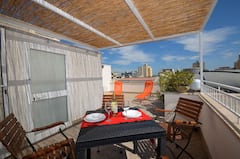Trapani lies in the westernmost part of the beautiful coast of Sicily in southern Italy. Trapani is the capital of the municipality of the same name. The city was built by the Elimyans and nowadays it is still an important port. Trapani is a city that people also call “Città del Sale,” which means the “City of Salt”. Salt is obtained by the evaporation of sea water and has become one of the most important parts of the local economy. The old Phoenicians founded the first salt tanks, and some of them still work today. Besides the important salt industry, the city also offers a picturesque old center with many significant sights. Read this list before you set off to Trapani and plan a great trip with these 10 top places of the city.
1. Salines of Trapani
As I mention, one of the important things to visit in Trapani is the old salines. Due to the great location and its important port, Trapani has been able to trade salt conveniently. The sea salt is top quality, and Trapani is referred to as the leading importer of Italy. A remarkable highlight of the salines is the old windmills, however only one windmill works today and the others are for the tourists only. Originally there were around 60 windmills that were used for pumping water and grinding the salt. On the road between Trapani and Marsala, called “Via de Sal,” you can see piles of pure white salt. You can book a tour with a guide and they are held in the “Saline di Trapani and Paceco,” the nature reserve since 1995.
Salines of Trapani
Address: Via Libica, 91100 Trapani TP, Italy
Contact: You can book your tour here: salineditrapani@wwf.it or via phone: +39 923867700
Website: Salines of Trapani (in Italian)
2. Museo delle Saline

The Museum of Salt is located in the old salt warehouse and consists of four rooms. The rooms offer: the history of the salt, the evolution of techniques of the 20th-century, salt in the 21st-century, and salt uses. The collection of the museum has about 1,000 elements of industrial archeology, and it’s the only museum of its kind in Italy. The outdoor exhibition shows the machines that are still used for graining the sea salt. So if you want to know more about the history and techniques of obtaining sea salt, then definitely visit this museum full of interesting information.
Museo delle Saline
Address: 1 Corso Vittorio Emanuele, 71044 Margherita di Savoia FG, Italy
Website: Museo delle Saline (in Italian)
3. Cattedrale di San Lorenzo

The Trapani Cathedral also called Cattedrale di San Lorenzo is a Roman Catholic church, devoted to Saint Lawrence. Saint Lawrence was one of the deacons of the city of Rome. Alfonso the Magnanimous ordered to build the cathedral in the 15th-century, which later became a parish. In the 19th-century, it was used as the bishop’s seat, following the creation of the Diocese of Trapani. Then the building was rebuilt several times. Its original form dated from the 18th-century and was carried out by the hands of the architect Giovanni Biagio Amico.
Cattedrale di San Lorenzo
Address: Corso Vittorio Emanuele, 91100 Trapani TP, Italy
You might be interested in these Airbnbs!
4. Museo Regionale Conte Agostino Pepoli
The former Carmelite convent was reconstructed to the museum between the 16th and 18th-century. The museum contains a collection of artwork that was created in Trapani and its surroundings. Trapani excelled in decorative arts, especially in works such as coral works, the majolica, native sculptures or work with precious metals. The main part of the collection is the private collection of Conte Agostino Pepoli. In the museum, we can also find the significant work from the gallery of Fardelliana or masterpieces by Conte Hernandez.
Museo Regionale Conte Agostino Pepoli
Address: Trapani - Via Conte Agostino Pepoli 180
5. Trapani port
The Port of Trapani is the primary connection to the islands of Aegadian and Pantelleria. It is a natural reservoir with a tactical position in western Sicily. For this reason, it is one of the important crossroads in the Mediterranean sea. The port will charm you with luxury yachts and old fishing boats. Every year the harbor organizes lot of events here, such as religious events or yacht races. A romantic waterfront is the perfect place for a relaxing walk. What about stopping by any of the restaurants here for dinner, while watching the sunset above the port?
6. Grotte di Scurati

Grotte di Scurati, in English, The Caves of Scurati, are the historic settlement in the municipality of Custonaci. Inside the caves are built-in small stone houses, inhabited until the 19th-century. The first archaeologist to explore this building was the Marquis of Guido Dalla Rosa and later, the Frenchman Raymond Vaufrey. Inside was found signs of human life, probably from the time of the Paleolithic. The Caves of Scurati are a group of nine caves: Mangiapane, Buffa, Crucifix, Rumen, Miceli, Cufuni, Clava, Maria Santissima, and Abyssus of Purgatory.
Grotta Mangiapane Grotta Mangiapane is the largest cave from the Caves of Scurati. There were many remnants and artifacts in this cave, such as animal teeth, bones and murals, which seemed to indicate the end of humanity. Some of them you can see in the Museo Regionale de Pepoli. This cave was inhabited until 1950 and belonged to the Magnapiane family.
Grotte di Scurati
Address: Via Scurati, 91015 Custonaci TP, Italy
Website: Grotte di Scurati
7. Ligny Tower

Ligny Tower is a watchtower of T. Rapany, built in 1671 on a strategic point on the western coast. The reason for tower and its position was to defend from Barbary attacks. The tower was named after Viceroy of Sicily Claude Lamoral, who ordered its construction. The tower was designed with a square base and the constructor of this project was Flemish Carlos de Grunenbergh. Nowadays, the tower is open to the public as an archaeological museum.
Ligny Tower
Address: Via Torre di Ligny, 37, 91100 Trapani TP, Italy
8. Piazza Mercato del Pesce
The remarkable square, located in the heart of the historic center of Trapani, used to be a former fish market for a long time. In the past, Trapani was one of the largest fishing fleets in the Mediterranean. 20 years ago you would have found the freshest fish in Sicily on the square. Due to the decline in marine life and hygiene, the market was canceled. The current form of the square, adorned with the arcade of arches and majestic fountain, was designed by Giovanbattista Salotti. Nowadays, the plaza holds small fairs, events, and exhibitions.
Piazza Mercato del Pesce
Address: Piazza del Mercato del Pesce, 91100 Trapani TP, Italy
9. Palazzo Riccio di Morana

The original Palace, built in neo-classical style, came from the 16th-century. In those days, it belonged to the wealthy family the Moranas. The original form was huge, but the family was forced to sell some parts, due to a low economy of salt. In the 17th-century, the palace was bought into the hands of nobility. Later in the 18th-century, it belonged to Don Giacomo Riccio, the Baron of Sant’Anna and Arcudaci, and the statues of the Riccio family adorned the facade, in the motives of fortitude, sadness, charity and fame. Today, the palace forms the premises of the Presidency of the Regional Province of Trapani.
Palazzo Riccio di Morana
Address: Viale Regina Margherita, 91100 Trapani TP, Italy
10. Fontana di Saturno - Fountain of Saturn
The Fountain of Saturn was one of the first fountains that distributed water to drink. The Chiaramonte family built the fountain as a gift to the city of Trapani. The water was drawn from the foot of Mount Erice through pipes that are no longer here. In the 18th-century, the fountain was adorned with a baroque statue of Saturn, the founder of Trapani, as the myth says.
Fountain of Saturn
Address: Piazza Saturno, 91100 Trapani TP, Italy
Explore the history of the former fishing port
Explore the lovely place that used to be a major fishing port and leading importer of salt of Italy. Find yourself in the picturesque streets of the historic center, filled with the longtime history of amazing Sicily. And as a bonus, plan your trip to be even more enjoyable with our recommendations.
History
Get Trip101 in your inbox
Unsubscribe in one click. See our Privacy Policy for more information on how we use your data

























Create an account to